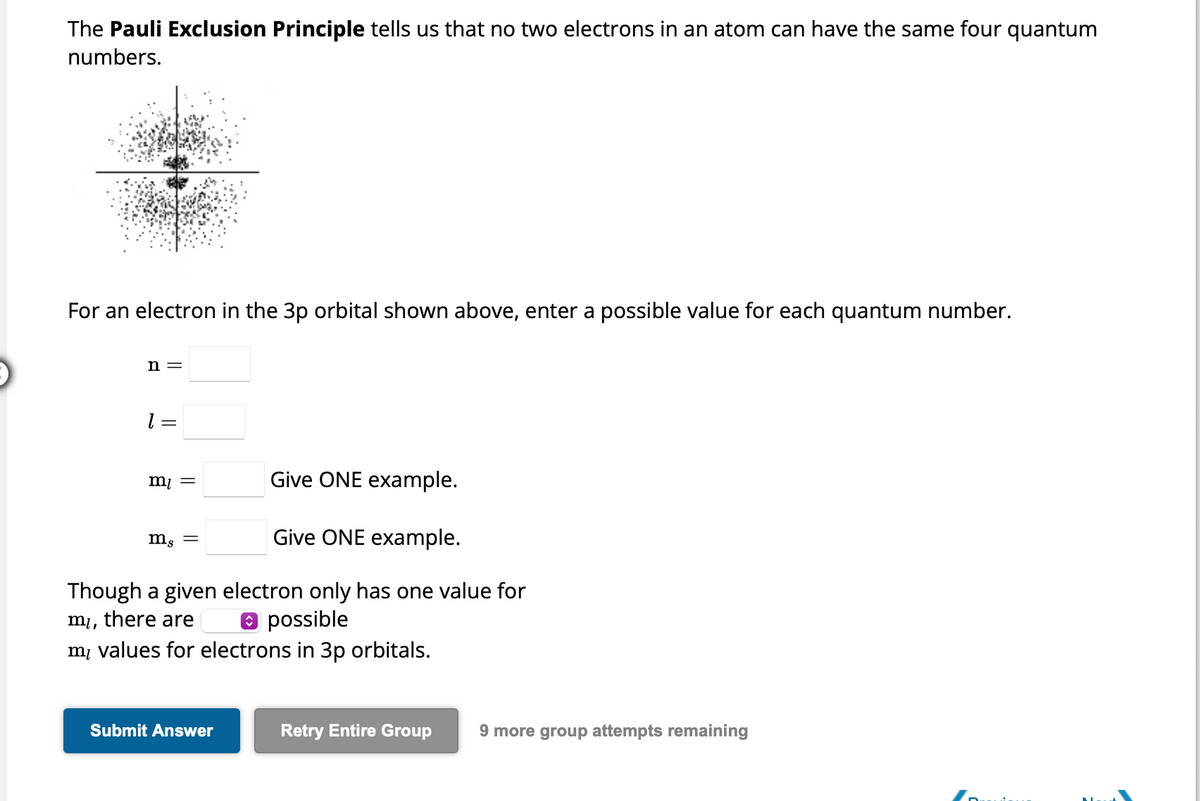The Pauli Exclusion Principle tells us that no two electrons in an atom can have the same four quantum numbers. For an electron in the 3p orbital shown above, enter a possible value for each quantum number. n = 1 = Give ONE example. Give ONE example. Though a given electron only has one value for my, there are possible my values for electrons in 3p orbitals. m = mg =
The Pauli Exclusion Principle tells us that no two electrons in an atom can have the same four quantum numbers. For an electron in the 3p orbital shown above, enter a possible value for each quantum number. n = 1 = Give ONE example. Give ONE example. Though a given electron only has one value for my, there are possible my values for electrons in 3p orbitals. m = mg =
Chemistry & Chemical Reactivity
9th Edition
ISBN:9781133949640
Author:John C. Kotz, Paul M. Treichel, John Townsend, David Treichel
Publisher:John C. Kotz, Paul M. Treichel, John Townsend, David Treichel
Chapter7: The Structure Of Atoms And Periodic Trends
Section: Chapter Questions
Problem 11PS: What is the maximum number of electrons that can be identified with each of the following sets of...
Related questions
Question

Transcribed Image Text:The Pauli Exclusion Principle tells us that no two electrons in an atom can have the same four quantum
numbers.
For an electron in the 3p orbital shown above, enter a possible value for each quantum number.
n =
1 = =
Give ONE example.
Give ONE example.
Though a given electron only has one value for
possible
mi,
there are
my values for electrons in 3p orbitals.
m₁ =
mg =
Submit Answer
Retry Entire Group
9 more group attempts remaining
Expert Solution
This question has been solved!
Explore an expertly crafted, step-by-step solution for a thorough understanding of key concepts.
This is a popular solution!
Trending now
This is a popular solution!
Step by step
Solved in 3 steps

Knowledge Booster
Learn more about
Need a deep-dive on the concept behind this application? Look no further. Learn more about this topic, chemistry and related others by exploring similar questions and additional content below.Recommended textbooks for you

Chemistry & Chemical Reactivity
Chemistry
ISBN:
9781133949640
Author:
John C. Kotz, Paul M. Treichel, John Townsend, David Treichel
Publisher:
Cengage Learning

Chemistry & Chemical Reactivity
Chemistry
ISBN:
9781337399074
Author:
John C. Kotz, Paul M. Treichel, John Townsend, David Treichel
Publisher:
Cengage Learning

Principles of Modern Chemistry
Chemistry
ISBN:
9781305079113
Author:
David W. Oxtoby, H. Pat Gillis, Laurie J. Butler
Publisher:
Cengage Learning

Chemistry & Chemical Reactivity
Chemistry
ISBN:
9781133949640
Author:
John C. Kotz, Paul M. Treichel, John Townsend, David Treichel
Publisher:
Cengage Learning

Chemistry & Chemical Reactivity
Chemistry
ISBN:
9781337399074
Author:
John C. Kotz, Paul M. Treichel, John Townsend, David Treichel
Publisher:
Cengage Learning

Principles of Modern Chemistry
Chemistry
ISBN:
9781305079113
Author:
David W. Oxtoby, H. Pat Gillis, Laurie J. Butler
Publisher:
Cengage Learning

Chemistry
Chemistry
ISBN:
9781305957404
Author:
Steven S. Zumdahl, Susan A. Zumdahl, Donald J. DeCoste
Publisher:
Cengage Learning


Chemistry: An Atoms First Approach
Chemistry
ISBN:
9781305079243
Author:
Steven S. Zumdahl, Susan A. Zumdahl
Publisher:
Cengage Learning